
Agriculture in Bolivia
Encyclopedia
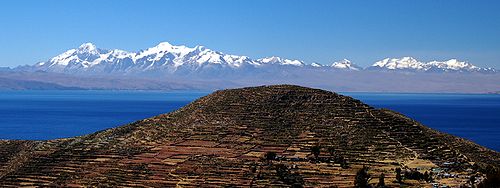
Tin
Tin is a chemical element with the symbol Sn and atomic number 50. It is a main group metal in group 14 of the periodic table. Tin shows chemical similarity to both neighboring group 14 elements, germanium and lead and has two possible oxidation states, +2 and the slightly more stable +4...
industry forced the country to diversify its productive and export base. Agricultural production as a share of GDP was approximately 23 percent in 1987, compared with 30 percent in 1960 and a low of just under 17 percent in 1979. The recession of the 1980s and unfavorable weather conditions, particularly drought
Drought
A drought is an extended period of months or years when a region notes a deficiency in its water supply. Generally, this occurs when a region receives consistently below average precipitation. It can have a substantial impact on the ecosystem and agriculture of the affected region...
s and floods, however, hampered output. Agriculture employed about 46 percent of the country's labor force in 1987. Most production, with the exception of coca
Coca
Coca, Erythroxylum coca, is a plant in the family Erythroxylaceae, native to western South America. The plant plays a significant role in many traditional Andean cultures...
, focused on the domestic market and self-sufficiency in food. Agricultural exports accounted for only about 15 percent of total exports in the late 1980s, depending on weather conditions and commodity prices for agricultural goods, hydrocarbon
Hydrocarbon
In organic chemistry, a hydrocarbon is an organic compound consisting entirely of hydrogen and carbon. Hydrocarbons from which one hydrogen atom has been removed are functional groups, called hydrocarbyls....
s, and mineral
Mineral
A mineral is a naturally occurring solid chemical substance formed through biogeochemical processes, having characteristic chemical composition, highly ordered atomic structure, and specific physical properties. By comparison, a rock is an aggregate of minerals and/or mineraloids and does not...
s.
Obstacles
Like the economy at large, agriculture faced major structural obstacles that kept it from reaching its vast potential. The lack of roads and easy access to ports hindered farmers from getting their produce to domestic markets and to the exportExport
The term export is derived from the conceptual meaning as to ship the goods and services out of the port of a country. The seller of such goods and services is referred to as an "exporter" who is based in the country of export whereas the overseas based buyer is referred to as an "importer"...
markets that provided the most potential for the sector's growth. A lack of credit for farmers was another long-standing problem, caused by government policies, the use of credit for political ends, and the strict lending procedures of the commercial banking sector. Bolivia also suffered from the worst farming technology in South America and an insufficient network of research and extension institutions to reverse that trend. The combined lack of infrastructure
Infrastructure
Infrastructure is basic physical and organizational structures needed for the operation of a society or enterprise, or the services and facilities necessary for an economy to function...
and technology
Technology
Technology is the making, usage, and knowledge of tools, machines, techniques, crafts, systems or methods of organization in order to solve a problem or perform a specific function. It can also refer to the collection of such tools, machinery, and procedures. The word technology comes ;...
made farmers vulnerable to almost yearly drought
Drought
A drought is an extended period of months or years when a region notes a deficiency in its water supply. Generally, this occurs when a region receives consistently below average precipitation. It can have a substantial impact on the ecosystem and agriculture of the affected region...
s and floods. The traditional use of pricing policies ensuring lower food prices for urban residents also lessened incentives for farmers. In addition, farmers increasingly had to compete with contraband
Contraband
The word contraband, reported in English since 1529, from Medieval French contrebande "a smuggling," denotes any item which, relating to its nature, is illegal to be possessed or sold....
imports in a wide range of agricultural products. Beyond these specific obstacles, agriculture, like all sectors of the economy, also suffered from the country's endemic political instability, economic mismanagement, and slow economic growth.
Potatoes
PotatoPotato
The potato is a starchy, tuberous crop from the perennial Solanum tuberosum of the Solanaceae family . The word potato may refer to the plant itself as well as the edible tuber. In the region of the Andes, there are some other closely related cultivated potato species...
es, the basic staple of highland Indians since pre-Inca times, has remained the most important food crop. In 1988 approximately 190,000 hectares, mostly in the highlands, produced 700,000 ton
Ton
The ton is a unit of measure. It has a long history and has acquired a number of meanings and uses over the years. It is used principally as a unit of weight, and as a unit of volume. It can also be used as a measure of energy, for truck classification, or as a colloquial term.It is derived from...
s of potatoes. These figures compared unfavorably, however, with 1975, when 127,680 hectares provided 834,000 tons of potatoes, indicating that yields were dwindling. Bolivia was generally self-sufficient in potatoes (over 200 varieties were grown), but imports were needed during occasional periods of drought or freezing
Freezing
Freezing or solidification is a phase change in which a liquid turns into a solid when its temperature is lowered below its freezing point. The reverse process is melting....
. Bolivia also exported some of its harvest to Brazil
Brazil
Brazil , officially the Federative Republic of Brazil , is the largest country in South America. It is the world's fifth largest country, both by geographical area and by population with over 192 million people...
. The lack of new seed varieties, chemical fertilizer
Fertilizer
Fertilizer is any organic or inorganic material of natural or synthetic origin that is added to a soil to supply one or more plant nutrients essential to the growth of plants. A recent assessment found that about 40 to 60% of crop yields are attributable to commercial fertilizer use...
s, and irrigation
Irrigation
Irrigation may be defined as the science of artificial application of water to the land or soil. It is used to assist in the growing of agricultural crops, maintenance of landscapes, and revegetation of disturbed soils in dry areas and during periods of inadequate rainfall...
systems, together with the continued exhaustion of the highland soils, was responsible for the low yields. In the late 1980s, the lack of financial credit at planting time represented the greatest impediment facing potato growers.
Corn
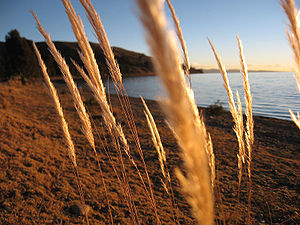
Maize
Maize known in many English-speaking countries as corn or mielie/mealie, is a grain domesticated by indigenous peoples in Mesoamerica in prehistoric times. The leafy stalk produces ears which contain seeds called kernels. Though technically a grain, maize kernels are used in cooking as a vegetable...
was the second major food crop, and its importance was growing. Corn covered more hectares than any other crop. In the late 1980s, approximately 300,000 hectares provided more than 475,000 tons of white corn, the traditional corn of Bolivia. Yellow Cuba
Cuba
The Republic of Cuba is an island nation in the Caribbean. The nation of Cuba consists of the main island of Cuba, the Isla de la Juventud, and several archipelagos. Havana is the largest city in Cuba and the country's capital. Santiago de Cuba is the second largest city...
n corn, grown in the tropical areas of Santa Cruz
Santa Cruz Department
Santa Cruz, with an area of 370,621 km², is the largest of the nine constituent departments of Bolivia. In the 2001 census, it reported a population of 2,029,471. The capital is the city of Santa Cruz de la Sierra. The state is one of the wealthiest states in Bolivia with huge reserves of...
, was becoming more common; 160,000 hectares produced 350,000 tons of yellow corn in 1988. Sixty percent of the corn, including both white and yellow varieties was grown by small farmers in the valleys, with the remaining 40 percent planted by medium-large farmers in Santa Cruz. Small farmers used at least half of their corn for human consumption, as animal feed, or for brewing chicha
Chicha
For the musical genre, see Peruvian cumbiaChicha is a term used in some regions of Latin America for several varieties of fermented and non-fermented beverages, rather often to those derived from maize and similar non-alcoholic beverages...
, the primary intoxicating beverage consumed by Bolivian Indians. The other half of their production and most of the commercially farmed corn were sold to Bolivia's forty private animal-feed plants, which bought 50 percent of the country's annual corn output. Many corn farmers were members of the Corn and Sorghum Producers Association (Productores de Maíz y Sorgo Promasor). Promasor was particularly active in Santa Cruz, where its members also produced 20,000 tons a year of sorghum
Sorghum
Sorghum is a genus of numerous species of grasses, one of which is raised for grain and many of which are used as fodder plants either cultivated or as part of pasture. The plants are cultivated in warmer climates worldwide. Species are native to tropical and subtropical regions of all continents...
, a drought-resistant crop, from some 6,000 hectares of land.
Rice and grains
RiceRice
Rice is the seed of the monocot plants Oryza sativa or Oryza glaberrima . As a cereal grain, it is the most important staple food for a large part of the world's human population, especially in East Asia, Southeast Asia, South Asia, the Middle East, and the West Indies...
has become an increasingly popular crop in Bolivia. Eaten by people in the lowlands and valleys since the 1950s, rice became the focus of government import-substitution policies beginning in the 1960s. In the late 1980s, the country was generally self-sufficient in rice production, some years importing and other years exporting. Bolivia's rice, however, was not of high quality by international standards, thus limiting export markets. In 1988 some 90,000 hectares of land, mostly in the Santa Cruz Department
Santa Cruz Department
Santa Cruz, with an area of 370,621 km², is the largest of the nine constituent departments of Bolivia. In the 2001 census, it reported a population of 2,029,471. The capital is the city of Santa Cruz de la Sierra. The state is one of the wealthiest states in Bolivia with huge reserves of...
and Beni Department
Beni Department
Beni, sometimes El Beni, is a northeastern department of Bolivia, in the lowlands region of the country. It is the second largest department in the country , covering 213,564 square kilometers , and it was created by supreme decree on November 18, 1842 during the administration of General José...
, produced 140,000 tons of rice. Bolivia imported onefifth of its total consumption of rice in 1988. Approximately 20,000 small farmers produced the bulk of the country's paddy rice and, in turn, sold it via truckers to thirty private rice mills.
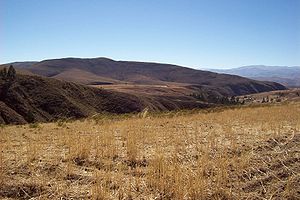
Barley
Barley is a major cereal grain, a member of the grass family. It serves as a major animal fodder, as a base malt for beer and certain distilled beverages, and as a component of various health foods...
was a common crop in the Bolivian highlands and was particularly well suited for the high altitudes. In 1988 the cultivation of 80,000 hectares by 300,000 highland farmers produced 75,000 tons of barley, which was used primarily in the country's notable beer
Beer
Beer is the world's most widely consumed andprobably oldest alcoholic beverage; it is the third most popular drink overall, after water and tea. It is produced by the brewing and fermentation of sugars, mainly derived from malted cereal grains, most commonly malted barley and malted wheat...
industry. About 10 percent of the barley was consumed on the farm as fodder, and Bolivia imported about one-quarter of its total consumption of barley in 1988.
Quinoa
Quinoa
Quinoa , a species of goosefoot , is a grain-like crop grown primarily for its edible seeds. It is a pseudocereal rather than a true cereal, or grain, as it is not a member of the grass family...
, the "mother grain" of the Incas, was the only food crop in the highlands that experienced sustained growth during the 1970s and 1980s. Cultivation of quinoa, which grows only above 2,000 meters, jumped from 15,640 hectares producing 9,000 tons in 1980 to 45,800 hectares producing 21,140 tons in 1984, and production continued to expand in the late 1980s. Quinoa is high in fiber
Fiber
Fiber is a class of materials that are continuous filaments or are in discrete elongated pieces, similar to lengths of thread.They are very important in the biology of both plants and animals, for holding tissues together....
and rich in protein
Protein
Proteins are biochemical compounds consisting of one or more polypeptides typically folded into a globular or fibrous form, facilitating a biological function. A polypeptide is a single linear polymer chain of amino acids bonded together by peptide bonds between the carboxyl and amino groups of...
, making it a potential health food in industrialized countries.
Despite repeated attempts by the government's National Wheat Institute (Instituto Nacional del Trigo) to make the nation selfsufficient in wheat
Wheat
Wheat is a cereal grain, originally from the Levant region of the Near East, but now cultivated worldwide. In 2007 world production of wheat was 607 million tons, making it the third most-produced cereal after maize and rice...
production, Bolivia produced only about 20 percent of the wheat that it consumed in the late 1980s. In 1988 about 88,000 hectares produced 60,000 tons of wheat and in the same year, 280,000 tons of wheat were imported. In 1988 the United States Agency for International Development
United States Agency for International Development
The United States Agency for International Development is the United States federal government agency primarily responsible for administering civilian foreign aid. President John F. Kennedy created USAID in 1961 by executive order to implement development assistance programs in the areas...
(AID) provided 180,000 tons of wheat through its Public Law 480 (PL-480) Food for Peace Program. Western Europe
Western Europe
Western Europe is a loose term for the collection of countries in the western most region of the European continents, though this definition is context-dependent and carries cultural and political connotations. One definition describes Western Europe as a geographic entity—the region lying in the...
and Canada operated programs similar to the AID program but on a smaller scale. Argentina
Argentina
Argentina , officially the Argentine Republic , is the second largest country in South America by land area, after Brazil. It is constituted as a federation of 23 provinces and an autonomous city, Buenos Aires...
provided wheat in exchange for Bolivian natural gas
Natural gas
Natural gas is a naturally occurring gas mixture consisting primarily of methane, typically with 0–20% higher hydrocarbons . It is found associated with other hydrocarbon fuel, in coal beds, as methane clathrates, and is an important fuel source and a major feedstock for fertilizers.Most natural...
. Smuggled wheat flour
Wheat flour
Wheat flour is a powder made from the grinding of wheat used for human consumption. More wheat flour is produced than any other flour. Wheat varieties are called "clean," "white," or "brown" if they have high gluten content, and they are called "soft" or "weak" flour if gluten content is low...
from Peru
Peru
Peru , officially the Republic of Peru , is a country in western South America. It is bordered on the north by Ecuador and Colombia, on the east by Brazil, on the southeast by Bolivia, on the south by Chile, and on the west by the Pacific Ocean....
and Argentina represented a serious threat to domestic wheat production. In 1988 analysts estimated that 60,000 tons of smuggled wheat had entered Bolivia annually. Small traditional farmers in the highlands and large soybean
Soybean
The soybean or soya bean is a species of legume native to East Asia, widely grown for its edible bean which has numerous uses...
farmers in Santa Cruz provided most of the country's 1988 wheat harvest, which was roughly equivalent to output in 1978, but only wheat from the Santa Cruz area was used for commercial milling. Analysts believed that wheat would produce higher yields when the proper tropical seeds, fertilizer, and irrigation methods were used.
Vegetables and fruits
Bolivians produced a wide range of vegetableVegetable
The noun vegetable usually means an edible plant or part of a plant other than a sweet fruit or seed. This typically means the leaf, stem, or root of a plant....
s, fruit
Fruit
In broad terms, a fruit is a structure of a plant that contains its seeds.The term has different meanings dependent on context. In non-technical usage, such as food preparation, fruit normally means the fleshy seed-associated structures of certain plants that are sweet and edible in the raw state,...
s, and other food crops, mostly for local consumption. The principal vegetable crops included kidney beans, green beans, chick peas, green peas, lettuce
Lettuce
Lettuce is a temperate annual or biennial plant of the daisy family Asteraceae. It is most often grown as a leaf vegetable. It is eaten either raw, notably in salads, sandwiches, hamburgers, tacos, and many other dishes, or cooked, as in Chinese cuisine in which the stem becomes just as important...
, cabbage
Cabbage
Cabbage is a popular cultivar of the species Brassica oleracea Linne of the Family Brassicaceae and is a leafy green vegetable...
, tomatoes, carrots, onions, garlic
Garlic
Allium sativum, commonly known as garlic, is a species in the onion genus, Allium. Its close relatives include the onion, shallot, leek, chive, and rakkyo. Dating back over 6,000 years, garlic is native to central Asia, and has long been a staple in the Mediterranean region, as well as a frequent...
, and chili pepper
Chili pepper
Chili pepper is the fruit of plants from the genus Capsicum, members of the nightshade family, Solanaceae. The term in British English and in Australia, New Zealand, India, Malaysia and other Asian countries is just chilli without pepper.Chili peppers originated in the Americas...
s. Also common were alfalfa
Alfalfa
Alfalfa is a flowering plant in the pea family Fabaceae cultivated as an important forage crop in the US, Canada, Argentina, France, Australia, the Middle East, South Africa, and many other countries. It is known as lucerne in the UK, France, Australia, South Africa and New Zealand, and known as...
, rye
Rye
Rye is a grass grown extensively as a grain and as a forage crop. It is a member of the wheat tribe and is closely related to barley and wheat. Rye grain is used for flour, rye bread, rye beer, some whiskeys, some vodkas, and animal fodder...
, cassava
Cassava
Cassava , also called yuca or manioc, a woody shrub of the Euphorbiaceae native to South America, is extensively cultivated as an annual crop in tropical and subtropical regions for its edible starchy tuberous root, a major source of carbohydrates...
, sweet potatoes and the fruits oranges
Orange (fruit)
An orange—specifically, the sweet orange—is the citrus Citrus × sinensis and its fruit. It is the most commonly grown tree fruit in the world....
, limes
Lime (fruit)
Lime is a term referring to a number of different citrus fruits, both species and hybrids, which are typically round, green to yellow in color, 3–6 cm in diameter, and containing sour and acidic pulp. Limes are a good source of vitamin C. Limes are often used to accent the flavors of foods and...
, grape
Grape
A grape is a non-climacteric fruit, specifically a berry, that grows on the perennial and deciduous woody vines of the genus Vitis. Grapes can be eaten raw or they can be used for making jam, juice, jelly, vinegar, wine, grape seed extracts, raisins, molasses and grape seed oil. Grapes are also...
s, apple
Apple
The apple is the pomaceous fruit of the apple tree, species Malus domestica in the rose family . It is one of the most widely cultivated tree fruits, and the most widely known of the many members of genus Malus that are used by humans. Apple grow on small, deciduous trees that blossom in the spring...
s, quince
Quince
The quince , or Cydonia oblonga, is the sole member of the genus Cydonia and native to warm-temperate southwest Asia in the Caucasus region...
, papaya
Papaya
The papaya , papaw, or pawpaw is the fruit of the plant Carica papaya, the sole species in the genus Carica of the plant family Caricaceae...
s, peach
Peach
The peach tree is a deciduous tree growing to tall and 6 in. in diameter, belonging to the subfamily Prunoideae of the family Rosaceae. It bears an edible juicy fruit called a peach...
es, plum
Plum
A plum or gage is a stone fruit tree in the genus Prunus, subgenus Prunus. The subgenus is distinguished from other subgenera in the shoots having a terminal bud and solitary side buds , the flowers in groups of one to five together on short stems, and the fruit having a groove running down one...
s, cherries, figs
FIGS
FIGS is an acronym for French, Italian, German, Spanish. These are usually the first four languages chosen to localize products into when a company enters the European market....
, avocado
Avocado
The avocado is a tree native to Central Mexico, classified in the flowering plant family Lauraceae along with cinnamon, camphor and bay laurel...
es, pineapple
Pineapple
Pineapple is the common name for a tropical plant and its edible fruit, which is actually a multiple fruit consisting of coalesced berries. It was given the name pineapple due to its resemblance to a pine cone. The pineapple is by far the most economically important plant in the Bromeliaceae...
s, strawberries, bananas, and plantain
Plantain
Plantain is the common name for herbaceous plants of the genus Musa. The fruit they produce is generally used for cooking, in contrast to the soft, sweet banana...
s.
Cash Crops
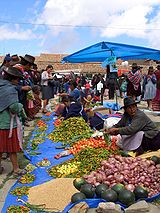
Coffee
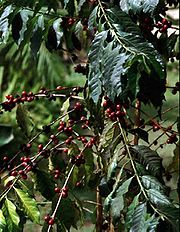
Coffee
Coffee is a brewed beverage with a dark,init brooo acidic flavor prepared from the roasted seeds of the coffee plant, colloquially called coffee beans. The beans are found in coffee cherries, which grow on trees cultivated in over 70 countries, primarily in equatorial Latin America, Southeast Asia,...
, another principal cash crop, was the second most important agricultural export after timber. As the primary substitute crop offered to coca growers under the eradication program, coffee was of particular importance. Coffee production reached 13,000 tons in 1988, nearly double the 1987 output, which was damaged by disease in western Bolivia. Over 20,000 hectares were devoted to coffee and Bolivia consumed 25 percent of its coffee crop locally in 1988, with the balance exported both legally and clandestinely. Legal exports of 102,000 bags, sixty kilograms each as measured by the International Coffee Organization
International Coffee Organization
International Coffee Organization was initiated in collaboration with UN to enhance cooperation between nations that consume, distribute and produce coffee....
(ICO), were equivalent to Bolivia's export quota for 1988, which was over US$15 million. An ICO member since 1968, Bolivia was permitted to export 170,000 of the sixty-kilogram bags in 1989. Approximately 25 percent of coffee exports left the country illegally in the late 1980s. Most coffee was grown by small farmers in the valleys or by large farmers in the lowlands. Most commercial farmers were members of the Bolivian Coffee Committee (Comité Boliviano del Café—Cobolca), which allocated ICO quotas. The coffee industry also received technical assistance from the Bolivian Institute of Coffee (Instituto Boliviano de Café), an autonomous government agency established in 1965 to run model farms and help control disease.
Sugar
Bolivia had been self-sufficient in sugarSugar
Sugar is a class of edible crystalline carbohydrates, mainly sucrose, lactose, and fructose, characterized by a sweet flavor.Sucrose in its refined form primarily comes from sugar cane and sugar beet...
production since 1963, although sugarcane had been grown since the colonial era. Sugarcane in the 1980s was a cash crop of significance for both the domestic and the export markets. In 1988 cultivation of sugarcane on 62,000 hectares produced 140,000 tons of sugar, figures which represent a sharp decline from 1986 figures. The price of sugar had skyrocketed in the mid-1970s, doubling the number of hectares under sugarcane cultivation in a few years. As sugar prices declined, however, farmers opted for more lucrative crops, such as soybeans. The decline in the sugar industry also was caused by poor management, dwindling yields, and poor quality control. In 1988 the country's six sugar mills operated at only 37 percent capacity. Sugarcane also was processed into methanol
Methanol
Methanol, also known as methyl alcohol, wood alcohol, wood naphtha or wood spirits, is a chemical with the formula CH3OH . It is the simplest alcohol, and is a light, volatile, colorless, flammable liquid with a distinctive odor very similar to, but slightly sweeter than, ethanol...
for the domestic and export markets. Continued controls on imports of sugar constituted one of the few exceptions to the import liberalization policies of the late 1980s.
Cotton
Although cottonCotton
Cotton is a soft, fluffy staple fiber that grows in a boll, or protective capsule, around the seeds of cotton plants of the genus Gossypium. The fiber is almost pure cellulose. The botanical purpose of cotton fiber is to aid in seed dispersal....
was a boom crop in the early 1970s, production had waned since 1975. Grown mostly in the Santa Cruz Department, cotton covered 54,000 hectares in 1975 but only 9,000 hectares in 1988. Production declined from 22,000 tons to 3,700 tons over the same period. Price was the primary reason for the decline, but insect problems, disease, and the lack of credit also contributed. Because Santa Cruz cotton farmers represented an important constituency, they had traditionally received highly favorable terms of credit. When cotton growing was no longer profitable, however, many cotton farmers defaulted on their loans, leaving the government's Agricultural Bank of Bolivia (Banco Agrícola de Bolivia—BAB) in a poor financial position in the late 1980s. Because of the precipitous decline in the industry, the country's ten cotton mills were operating at under one-half of their capacity by the late 1980s.
Cash crops of lesser importance included tobacco
Tobacco
Tobacco is an agricultural product processed from the leaves of plants in the genus Nicotiana. It can be consumed, used as a pesticide and, in the form of nicotine tartrate, used in some medicines...
, tea
Tea
Tea is an aromatic beverage prepared by adding cured leaves of the Camellia sinensis plant to hot water. The term also refers to the plant itself. After water, tea is the most widely consumed beverage in the world...
, cocoa, and oilseeds, such as sesame
Sesame
Sesame is a flowering plant in the genus Sesamum. Numerous wild relatives occur in Africa and a smaller number in India. It is widely naturalized in tropical regions around the world and is cultivated for its edible seeds, which grow in pods....
, peanuts
Peanuts
Peanuts is a syndicated daily and Sunday American comic strip written and illustrated by Charles M. Schulz, which ran from October 2, 1950, to February 13, 2000, continuing in reruns afterward...
, castor beans, and sunflower
Sunflower
Sunflower is an annual plant native to the Americas. It possesses a large inflorescence . The sunflower got its name from its huge, fiery blooms, whose shape and image is often used to depict the sun. The sunflower has a rough, hairy stem, broad, coarsely toothed, rough leaves and circular heads...
s. Approximately 1,000 tons of tobacco for the Bolivian market were grown on about 1,000 hectares. Tea was grown as a secondary crop in the Yungas, Alto Beni (Upper Beni), and Santa Cruz areas. Eighty percent of the country's cacao trees, from which cocoa is derived, were grown in the Alto Beni by a network of cooperatives that were increasingly involved in processing cocoa and exporting chocolate
Chocolate
Chocolate is a raw or processed food produced from the seed of the tropical Theobroma cacao tree. Cacao has been cultivated for at least three millennia in Mexico, Central and South America. Its earliest documented use is around 1100 BC...
products. Oilseeds were an important part of both the agricultural and the manufacturing sectors but the growing dominance of soybeans, however, diminished the role of other oilseeds in the economy.
Coca
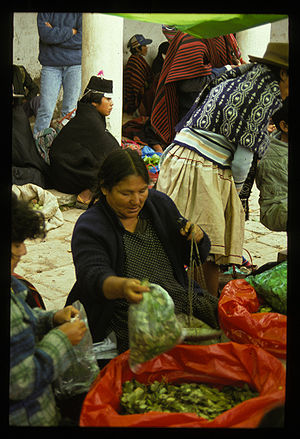
Cocaine
Cocaine is a crystalline tropane alkaloid that is obtained from the leaves of the coca plant. The name comes from "coca" in addition to the alkaloid suffix -ine, forming cocaine. It is a stimulant of the central nervous system, an appetite suppressant, and a topical anesthetic...
. The country was the second largest grower of coca in the world, supplying approximately 15 percent of the United States cocaine market in the late 1980s. Analysts believed that exports of coca paste or cocaine generated from US$600 million to US$1 billion annually in the 1980s, depending on prices and output. Based on these estimates, coca-related exports equaled or surpassed the country's legal exports. Coca has been grown in Bolivia for centuries. The coca plant, a tea-like shrub, was cultivated mostly by small farmers in the Chapare and Yungas regions. About 65 percent of all Bolivian coca was grown in the Chapare
Chapare
Chapare may refer to:* Chapare Province, Bolivia* Chapare RiverIt may also refer to:* Chapare virus...
region of Cochabamba Department
Cochabamba Department
Cochabamba is one of the nine component departments of Bolivia. It is known to be the "granary" of the country because of its variety of agricultural products due to Cochabamba's geographical position. It has an area of 55,631 km². Its population, in the 2007 census, was 1,750,000...
; other significant coca-growing areas consisted of the Yungas of La Paz Department and various areas of Santa Cruz and thr Tarija Department
Tarija Department
Tarija is a department in Bolivia. It is located in south-eastern Bolivia bordering Argentina to the south and Paraguay to the east. According to the 2001 census, it has a population of 391,226 inhabitants. It has an area of 37.623 km²...
.
Bolivian farmers rushed to grow coca in the 1980s as its price climbed and the economy collapsed. Soaring unemployment also contributed to the boom. In addition, farmers turned to coca for its quick economic return, its light weight, its yield of four crops a year, and the abundance of United States dollars available in the trade, a valuable resource in a hyperinflated economy. The Bolivian government estimated that coca production had expanded from 1.63 million kilograms of leaves covering 4,100 hectares in 1977 to a minimum of 45 million kilograms over an area of at least 48,000 hectares in 1987. The number of growers expanded from 7,600 to at least 40,000 over the same period. Besides growers, the coca networks employed numerous Bolivians, including carriers (zepeadores), manufacturers of coca paste and cocaine, security personnel, and a wide range of more nefarious positions. The unparalleled revenues made the risk worthwhile for many.
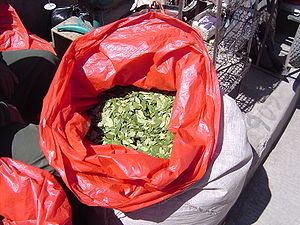
The economics of eradication were particularly frustrating. As more coca was destroyed, the local price increased, making it more attractive to other growers. Bolivia, however, was seeking additional funds from the United States and Western Europe to proceed with an eradication plan that was supposed to provide peasant
Peasant
A peasant is an agricultural worker who generally tend to be poor and homeless-Etymology:The word is derived from 15th century French païsant meaning one from the pays, or countryside, ultimately from the Latin pagus, or outlying administrative district.- Position in society :Peasants typically...
s US$2,000 per hectare eradicated. In 1988 coca growing became technically illegal outside a specially mandated 12,000- hectare area in the Yungas. A four-year government eradication campaign begun in 1989 sought to convert 55 percent of coca areas into legal crops. Coffee and citrus fruits were offered as alternative crops to coca despite the fact that their return was a fraction of that of coca.
The cocaine industry had a generally deleterious effect on the Bolivian economy not to mention having a serious environmental impact on rivers and rmeoval of forest for coca plantations. The cocaine trade greatly accelerated the predominance of the United States dollar in the economy and the large black market for currency, thereby helping to fuel inflation in the 1980s. The escalation of coca cultivation also damaged the output of fruits and coffee, which were mostly destined for local consumption. Coca's high prices, besides being generally inflationary, also distorted other sectors, especially labor markets. Manufacturers in the Cochabamba area during the 1980s found it impossible to match the wages workers could gain in coca, making their supply of labor unreliable and thus harming the formal economy.
Livestock
.jpg)
Livestock
Livestock refers to one or more domesticated animals raised in an agricultural setting to produce commodities such as food, fiber and labor. The term "livestock" as used in this article does not include poultry or farmed fish; however the inclusion of these, especially poultry, within the meaning...
production was active and well diversified. Beef
Beef
Beef is the culinary name for meat from bovines, especially domestic cattle. Beef can be harvested from cows, bulls, heifers or steers. It is one of the principal meats used in the cuisine of the Middle East , Australia, Argentina, Brazil, Europe and the United States, and is also important in...
cattle numbered an estimated 6 million in 1988 and dominated all livestock production, being the most popular meat in Bolivia. Unlike the rest of the agricultural sector, beef output grew over 4 percent a year during the 1980s. Over 70 percent of all cattle were raised in the eastern plains; Beni was responsible for over 40 percent of the national herd
Herd
Herd refers to a social grouping of certain animals of the same species, either wild or domestic, and also to the form of collective animal behavior associated with this or as a verb, to herd, to its control by another species such as humans or dogs.The term herd is generally applied to mammals,...
. Twenty percent of all cattle were found in the valleys and about 10 percent in the highlands, where they had served as beasts of burden since the Spanish
Spain
Spain , officially the Kingdom of Spain languages]] under the European Charter for Regional or Minority Languages. In each of these, Spain's official name is as follows:;;;;;;), is a country and member state of the European Union located in southwestern Europe on the Iberian Peninsula...
introduced cattle in colonial times. In 1988 Bolivia slaughtered 200,000 tons of cattle and exported 48,000 live cattle to Brazil, as well as processed beef to Chile
Chile
Chile ,officially the Republic of Chile , is a country in South America occupying a long, narrow coastal strip between the Andes mountains to the east and the Pacific Ocean to the west. It borders Peru to the north, Bolivia to the northeast, Argentina to the east, and the Drake Passage in the far...
and Peru. The country's medium and large cattle ranchers were organized into two large producer associations one in Beni and one in Santa Cruz that marketed beef and attempted to set domestic prices. Bolivia had the potential to double its beef output in a relatively short period of time.
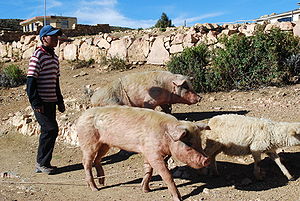
Milk
Milk is a white liquid produced by the mammary glands of mammals. It is the primary source of nutrition for young mammals before they are able to digest other types of food. Early-lactation milk contains colostrum, which carries the mother's antibodies to the baby and can reduce the risk of many...
consumption among Bolivians was among the lowest in the world. In 1988 Bolivia consumed 130,000 tons of milk, 80,000 tons from its five dairies, 23,000 tons in donations from developed countries, and the rest in contraband, mostly in the form of evaporated milk
Evaporated milk
Evaporated milk, also known as dehydrated milk, is a shelf-stable canned milk product with about 60% of the water removed from fresh milk. It differs from sweetened condensed milk, which contains added sugar. Sweetened condensed milk requires less processing since the added sugar inhibits ...
. Dairy farms were medium to large in size and were concentrated in Cochabamba and Santa Cruz departments. The government was involved heavily in the dairy industry, but it was generally ineffective in improving nutritional levels in dairy products.
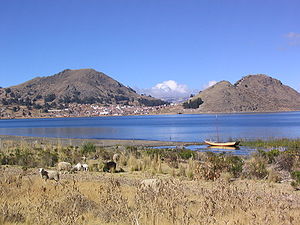
Chicken
The chicken is a domesticated fowl, a subspecies of the Red Junglefowl. As one of the most common and widespread domestic animals, and with a population of more than 24 billion in 2003, there are more chickens in the world than any other species of bird...
s, pigs, sheep, goat
Goat
The domestic goat is a subspecies of goat domesticated from the wild goat of southwest Asia and Eastern Europe. The goat is a member of the Bovidae family and is closely related to the sheep as both are in the goat-antelope subfamily Caprinae. There are over three hundred distinct breeds of...
s, llama
Llama
The llama is a South American camelid, widely used as a meat and pack animal by Andean cultures since pre-Hispanic times....
s, alpaca
Alpaca
An alpaca is a domesticated species of South American camelid. It resembles a small llama in appearance.Alpacas are kept in herds that graze on the level heights of the Andes of southern Peru, northern Bolivia, Ecuador, and northern Chile at an altitude of to above sea level, throughout the year...
s, vicuñas, and even buffalo
American Bison
The American bison , also commonly known as the American buffalo, is a North American species of bison that once roamed the grasslands of North America in massive herds...
. Chicken production also was centered in Cochabamba and Santa Cruz departments and experienced strong growth in the 1980s. Although the poultry industry faced high feed costs and substantial Chilean contraband, it produced 25 million broilers and 200 million eggs
Egg (food)
Eggs are laid by females of many different species, including birds, reptiles, amphibians, and fish, and have probably been eaten by mankind for millennia. Bird and reptile eggs consist of a protective eggshell, albumen , and vitellus , contained within various thin membranes...
in 1988. The pork industry, also facing high feed costs, remained small. The pig population was estimated at slightly over 1 million, and the annual slaughter was roughly 45,000 tons of pork. Santa Cruz was expected to be the location of the pork industry's future growth. There were an estimated 10 million sheep and 1 million goats in Bolivia, mostly in the highlands, which was also home to 3 million llamas, 350,000 alpacas, and a dwindling number of vicuñas. Appreciated for their fine wool
Wool
Wool is the textile fiber obtained from sheep and certain other animals, including cashmere from goats, mohair from goats, qiviut from muskoxen, vicuña, alpaca, camel from animals in the camel family, and angora from rabbits....
and meat, llamas, arpacas, and vicunas received government protection because of their declining numbers.
Forestry and fishing
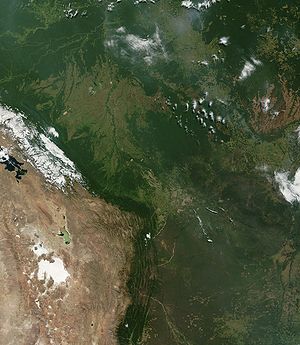
Woodland
Ecologically, a woodland is a low-density forest forming open habitats with plenty of sunlight and limited shade. Woodlands may support an understory of shrubs and herbaceous plants including grasses. Woodland may form a transition to shrubland under drier conditions or during early stages of...
s were one of the areas with the most potential for growth in agriculture. Official wood production grew by a third from the late 1970s to the late 1980s, when timber exports surpassed all other agricultural exports. Timber
Timber
Timber may refer to:* Timber, a term common in the United Kingdom and Australia for wood materials * Timber, Oregon, an unincorporated community in the U.S...
exports in 1987 reached US$31 million. Contraband in wood products, however, was expected to be equivalent to official exports. Most of the smuggled wood was destined for Brazil. Bolivia's eastern lowlands are richly endowed with hundreds of species of trees, scores of which have been commercially timbered. Deforestation
Deforestation
Deforestation is the removal of a forest or stand of trees where the land is thereafter converted to a nonforest use. Examples of deforestation include conversion of forestland to farms, ranches, or urban use....
and the threat of erosion caused by slash-and-burn agriculture and colonization were growing concerns in the lowlands. The government's Center for Forestry Development (Centro de Desarrollo Forestal) monitored the country's forests.
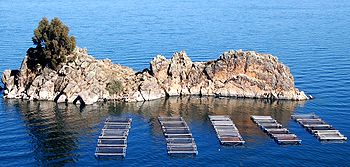
Protein
Proteins are biochemical compounds consisting of one or more polypeptides typically folded into a globular or fibrous form, facilitating a biological function. A polypeptide is a single linear polymer chain of amino acids bonded together by peptide bonds between the carboxyl and amino groups of...
in the Bolivian's protein
Protein
Proteins are biochemical compounds consisting of one or more polypeptides typically folded into a globular or fibrous form, facilitating a biological function. A polypeptide is a single linear polymer chain of amino acids bonded together by peptide bonds between the carboxyl and amino groups of...
-deficient diet, but river fishing was mostly for direct consumption. With assistance from the British, the government was attempting to promote commercial fishing in the lowlands. Several processing plants were being considered to market the trout, pacú, and dorados that filled the many rivers of the Oriente.
Land tenure
Before the 1952 Revolution, Bolivia's land distribution was the worst in Latin AmericaLatin America
Latin America is a region of the Americas where Romance languages – particularly Spanish and Portuguese, and variably French – are primarily spoken. Latin America has an area of approximately 21,069,500 km² , almost 3.9% of the Earth's surface or 14.1% of its land surface area...
with some 4 percent of all landowners possessing more than 82 percent of the land. A major success of the land reform program was the redistribution of nearly 50 percent of peasant lands within its first two years. Although greatly improved from the pre-revolutionary period, broad disparities in land tenure remained in the 1980s. Analysts estimated that over 90 percent of the farms in the highlands and valleys remained under twenty hectares in the 1980s. These farms typically were one to three hectares in size and were worked by nearly 80 percent of Bolivia's more than 700,000 farmers. The majority of farmers in the highlands were also members of agricultural cooperatives. Only 40 percent of the farms in the eastern and northern lowlands were under twenty hectare
Hectare
The hectare is a metric unit of area defined as 10,000 square metres , and primarily used in the measurement of land. In 1795, when the metric system was introduced, the are was defined as being 100 square metres and the hectare was thus 100 ares or 1/100 km2...
s; the most common size in that region was fifty to seventy-five hectares, but subsistence farming existed as well.
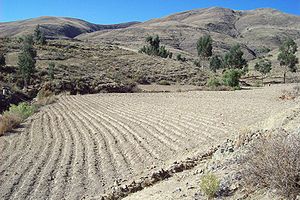
Twenty percent of the country's farmers were located in the relatively fertile valleys. These farmers fared much better than their Altiplano counterparts on the high plateau (Altiplano
Altiplano
The Altiplano , in west-central South America, where the Andes are at their widest, is the most extensive area of high plateau on Earth outside of Tibet...
) between the two mountain ranges in western Bolivia. Plots averaged between five and ten hectares, and because of the more fertile and less exhausted soils, a larger share of that land was in use compared with the Altiplano. Farmers in the valleys were frequently able to harvest two crops annually, as opposed to the one crop a year on the Altiplano.
The largest farms were found on the sprawling and often isolated eastern lowlands, where about 20 percent of the country's farmers worked 65 percent of the country's land. The lowlands produced the bulk of all agricultural output and virtually all of the sector's exports. Although about 16 percent of the lowland farms were of subsistence size (five hectares or fewer), the great majority of the region's land was owned by medium-to-large landowners actively engaged in commercial agriculture. The power center of the agricultural sector was located in the southeastern department of Santa Cruz, where landholdings often exceeded 5,000 hectares.
Land reform and land policy
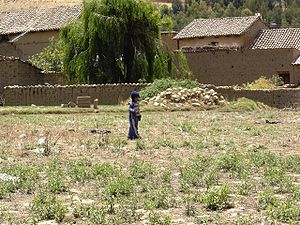
Land reform
[Image:Jakarta farmers protest23.jpg|300px|thumb|right|Farmers protesting for Land Reform in Indonesia]Land reform involves the changing of laws, regulations or customs regarding land ownership. Land reform may consist of a government-initiated or government-backed property redistribution,...
policies of the early 1950s were implemented much more rapidly and completely than those of other Latin American countries. The land reform essentially allowed peasants to claim the land that they had traditionally worked. For this reason, however, the size of many peasant plots did not increase as a result of the reform.
In retrospect, land reform was more of a social success than an economic one. Although the reform improved income distribution, its main contribution was to transform a feudal society into a market society. Land reform has remained a goal of successive governments since 1952, but the pace and scope of reform slowed. The original Agrarian Reform Law was amended in 1963 and 1968. By 1986 the government claimed to have redistributed 33 million hectares through the reform process. But although peasants ate better, agricultural production did not increase in the way most government officials expected. In addition, the reform process was hampered by price controls
Price controls
Price controls are governmental impositions on the prices charged for goods and services in a market, usually intended to maintain the affordability of staple foods and goods, and to prevent price gouging during shortages, or, alternatively, to insure an income for providers of certain goods...
, a lack of extension services, inadequate credit, insufficient infrastructure, and regional conflicts between the highlands and lowlands. The growth of the agricultural sector was barely positive during the 1950s, and annual growth, especially among food crops, did not keep pace with population growth, thus requiring increased imports of foodstuffs
Foodstuffs
Foodstuffs is a group of three New Zealand grocery and liquor retailers' cooperatives based in Auckland, Wellington and Christchurch which collectively control an estimated 57% of the New Zealand grocery market...
.
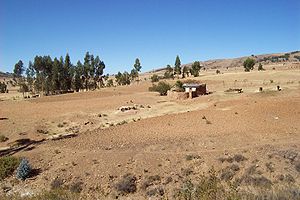
Although government policy has encouraged colonization of these isolated areas since the 1940s, the process did not accelerate until the 1950s, when a major highway connected Cochabamba
Cochabamba
Cochabamba is a city in central Bolivia, located in a valley bearing the same name in the Andes mountain range. It is the capital of the Cochabamba Department and is the fourth largest city in Bolivia with an urban population of 608,276 and a metropolitan population of more than 1,000,000 people...
with Santa Cruz and a rail system linked Santa Cruz with São Paulo
São Paulo
São Paulo is the largest city in Brazil, the largest city in the southern hemisphere and South America, and the world's seventh largest city by population. The metropolis is anchor to the São Paulo metropolitan area, ranked as the second-most populous metropolitan area in the Americas and among...
, Brazil. The settlers included members of the former ruling oligarchy
Oligarchy
Oligarchy is a form of power structure in which power effectively rests with an elite class distinguished by royalty, wealth, family ties, commercial, and/or military legitimacy...
who had lost land in the reform, as well as more risk-taking highlanders, or Kollas, who came as wage laborers or who bought land. In order to facilitate the colonization process, the government created the National Colonization Institute (Instituto Nacional de Colonización—INC), which typically helped highland families move to newly established government colonies, sometimes completely isolated from other towns. From 1952 to the mid-1970s, the government helped 46,000 families (190,000 people) colonize the lowlands. Governmentsponsored colonization, however, accounted for just 15 percent of all the pioneers who ventured east. Furthermore, INC colonies suffered a high dropout rate among participants, many of whom faulted the INC for providing insufficient support services and too few roads. Other settlers included members of Japanese and North American Mennonite communities who were establishing colonies in neighboring Paraguay
Paraguay
Paraguay , officially the Republic of Paraguay , is a landlocked country in South America. It is bordered by Argentina to the south and southwest, Brazil to the east and northeast, and Bolivia to the northwest. Paraguay lies on both banks of the Paraguay River, which runs through the center of the...
.
Land policy and government agricultural policy in general shifted dramatically when orthodox economic policies were implemented in 1985. The government, which had once monopolized the production of many key crops, set prices, marketed goods, and closely controlled credit, now effectively withdrew from the sector. As a result, farmers in the late 1980s were in transition from a period characterized by import protection and close cooperation with the government to one of free competition with highly advanced international markets and contraband.
Land use
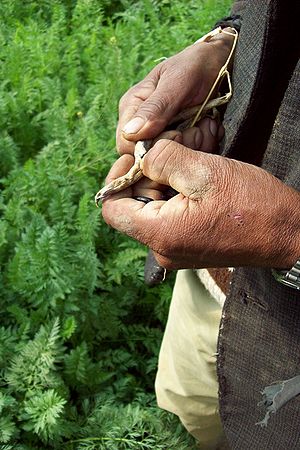
Arable land
In geography and agriculture, arable land is land that can be used for growing crops. It includes all land under temporary crops , temporary meadows for mowing or pasture, land under market and kitchen gardens and land temporarily fallow...
but not in use. Of the land deemed suitable for agricultural use, only about 10 percent was in use.
As with land tenure, the country's land use was best explained in terms of its geography. Most highland farmers worked minifundia plots of staples and vegetables, such as potatoes, corn, haba beans, and quinoaa, the Bolivian cereal grain, selling only 30 percent of their output. Produce usually was marketed to truckers, the most common marketing outlet for Bolivian farmers, or was sold at large agricultural fairs, an Inca custom. Although Indians in the highlands terraced their steep fields in the Inca style, traditional farming techniques also made farmers vulnerable to frost, irregular rainfall, and erosion. Farm animals plowed the soil, and the abundance of sheep, llamas, and alpaca, used as a form of insurance income against bad weather, made overgrazing common, thus further eroding the soil and lessening soil fertility.
Farmers in the valleys used their farmland for a mixture of traditional and nontraditional purposes, producing both food and cash crops. The primary food crops were tubers, barley, corn, wheat, fruits, and vegetables. Export crops such as cacao, tea, and coffee were also planted, the latter because of the ideal altitude. Livestock activity also was common. Although yields were not always high, the valleys usually produced two crops a year and were less vulnerable to weather fluctuations than on the Altiplano. Nevertheless, farmers in the valleys also relied on truckers for their marketing and suffered greater isolation than those on the Altiplano, particularly during the rainy season, October to April. Although farmers in the valleys took more risks than those on the Altiplano, they still suffered from a low technological level and the lack of direct access to markets.
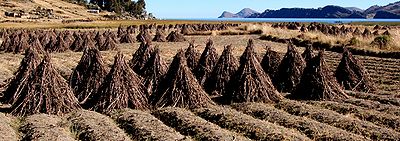
Marketing
Marketing is the process used to determine what products or services may be of interest to customers, and the strategy to use in sales, communications and business development. It generates the strategy that underlies sales techniques, business communication, and business developments...
, and even research
Research
Research can be defined as the scientific search for knowledge, or as any systematic investigation, to establish novel facts, solve new or existing problems, prove new ideas, or develop new theories, usually using a scientific method...
and development. These farmers were organized into powerful producer organizations that traditionally negotiated prices with the government and provided technical assistance to members. Small farmers also continued to occupy Santa Cruz and many were responsible for the growing problems of deforestation because of slash-and-burn approaches to rice farming. An estimated 100,000 landless wage earners in the agricultural sector cut sugarcane or picked cotton in Santa Cruz or performed seasonal labor in Argentina.
The northern lowland departments of Pando
Pando Department
Pando is a department of Bolivia, with an area of , adjoining the border with Brazil. Pando has a population 66,689 . Its capital is the city of Cobija....
and Beni were much more isolated than Santa Cruz, thus limiting their ability to be major agricultural producers. They were originally settled in the late 19th century during a boom in rubber
Rubber
Natural rubber, also called India rubber or caoutchouc, is an elastomer that was originally derived from latex, a milky colloid produced by some plants. The plants would be ‘tapped’, that is, an incision made into the bark of the tree and the sticky, milk colored latex sap collected and refined...
exports from the Amazon region. As colonization proceeded, larger-scale commercial agriculture developed in coffee, rice, and especially cattle. By the 1960s, large cattle ranches of 500 hectares and more flourished in Beni, making it the cattle capital of the country. In the 1980s, Beni Department also became an important producer of commercial timber.
Farming technology
The use of purchased items such as fertilizers, tractorTractor
A tractor is a vehicle specifically designed to deliver a high tractive effort at slow speeds, for the purposes of hauling a trailer or machinery used in agriculture or construction...
s, and irrigation systems were extremely low in the 1980s because traditional farming methods continued to dominate. Because of their isolation and lack of technical support, Bolivian farmers used less fertilizer, about two kilograms per hectare, than any other country in the Western Hemisphere. Most small farmers used natural fertilizers, such as manure
Manure
Manure is organic matter used as organic fertilizer in agriculture. Manures contribute to the fertility of the soil by adding organic matter and nutrients, such as nitrogen, that are trapped by bacteria in the soil...
, but even large farms in Santa Cruz found chemical fertilizers (all of which were imported) expensive because of transportation costs. The signing of an accord for a natural gas pipeline with Brazil in 1988, however, improved Bolivia's prospects for manufacturing its own chemical fertilizers. Bolivia's use of tractors, 0.2 per 1,000 hectares, was also the lowest in the Western Hemisphere. Most tractors were used in Santa Cruz. As the lowlands took on a greater role in agriculture, that ratio was expected to improve. By the late 1980s, just about 5 percent of the country's land was irrigated, one-third more than a decade earlier.
Government extension services for farmers remained extremely inadequate in the late 1980s. Only one agricultural agent existed for each 7,000 farming households. The chief research institution for agriculture was the Bolivian Institute for Agricultural Technology (Instituto Boliviano de Tecnología Agrícola—IBTA). Established in the mid-1970s, the IBTA concentrated mainly on new seed varieties for cash crops in the lowlands. The Institute for the Rural Development of the Altiplano (Instituto para el Desarrollo Rural del Altiplano—IDRA), the Center for Tropical Agricultural Research (Centro de Investigaciones de Agricultura Tropical—CIAT), and the national universities performed further research into this field.
Irrigation infrastructure
Bolivia has approximately 226,500 irrigated hectares (ha) or about 11% of the total agricultural land 2,100,000 ha. There are about 5,000 irrigation systems in Bolivia, most of them located in the South and Southwestern areas (Valles and Antiplano). These irrigation systems consist of rudimentary web of canals supplied by rainfall with few regulatory schemes such as dams, which makes them very vulnerable to seasonality of rain. Overall efficiency of irrigation systems varies from 18-30% in traditional systems to 35-50% in improved systems.
| Department | Micro (10ha) | Small (100ha) | Medium (500ha) | Big (>500ha) | Total |
|---|---|---|---|---|---|
| Chuquisaca Chuquisaca Department Chuquisaca is a department of Bolivia located in the center south. It borders on the departments of Cochabamba, Tarija, Potosí, and Santa Cruz. The departmental capital is Sucre, which is also the constitutional capital of Bolivia.-Geography:... |
1,653 | 11,370 | 4,261 | 3,884 | 21,168 |
| Cochabamba Cochabamba Cochabamba is a city in central Bolivia, located in a valley bearing the same name in the Andes mountain range. It is the capital of the Cochabamba Department and is the fourth largest city in Bolivia with an urban population of 608,276 and a metropolitan population of more than 1,000,000 people... |
1,938 | 22,225 | 27,403 | 35,968 | 81,925 |
| La Paz La Paz Nuestra Señora de La Paz is the administrative capital of Bolivia, as well as the departmental capital of the La Paz Department, and the second largest city in the country after Santa Cruz de la Sierra... |
1,703 | 21,047 | 6,052 | 7,192 | 35,994 |
| Oruro Oruro Department Oruro is a department in Bolivia, with an area of 53,588 km². Its capital is the city of Oruro. At the time of census 2001 it had a population of 391,870.- Provinces of Oruro :... |
940 | 3,638 | 440 | 9,021 | 14,039 |
| Potosi Potosí Department Potosí Department is a department in southwestern Bolivia. It comprises 118,218 km² with 709,013 inhabitants . The capital is the city of Potosí.... |
3,240 | 10,146 | 2,254 | 600 | 16,240 |
| Santa Cruz Santa Cruz Department Santa Cruz, with an area of 370,621 km², is the largest of the nine constituent departments of Bolivia. In the 2001 census, it reported a population of 2,029,471. The capital is the city of Santa Cruz de la Sierra. The state is one of the wealthiest states in Bolivia with huge reserves of... |
269 | 5,456 | 8,434 | 1,080 | 15,239 |
| Tarija Tarija Department Tarija is a department in Bolivia. It is located in south-eastern Bolivia bordering Argentina to the south and Paraguay to the east. According to the 2001 census, it has a population of 391,226 inhabitants. It has an area of 37.623 km²... |
785 | 12,755 | 17,101 | 5,710 | 36,351 |
| Total | 10,528 | 86,638 | 65,944 | 63,454 | 226,564 |
Source: Ministerio del Agua
Linkages with water resources
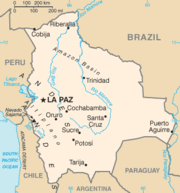
Lake Titicaca
Lake Titicaca is a lake located on the border of Peru and Bolivia. It sits 3,811 m above sea level, making it the highest commercially navigable lake in the world...
basin.
The hydrographic system consists of three large basins: the Amazon Basin
Amazon Basin
The Amazon Basin is the part of South America drained by the Amazon River and its tributaries that drains an area of about , or roughly 40 percent of South America. The basin is located in the countries of Bolivia, Brazil, Colombia, Ecuador, Guyana, Peru, and Venezuela...
which measures approximately 724,000 km2 and covers 66% of Bolivia's territory; the closed (endorreic) basin, which measures 145,081 km2 or 13% of the territory; and the Rio Plata Basin
Paraguay River
The Paraguay River is a major river in south central South America, running through Brazil, Bolivia, Paraguay, and Argentina...
, which covers 229,500 km2 or 21% of the nation's territory.
The Amazon basin has a high flow of water and it is prone to floods. The quantity and quality of hydrological information is very poor.
Environmental impacts of irrigation
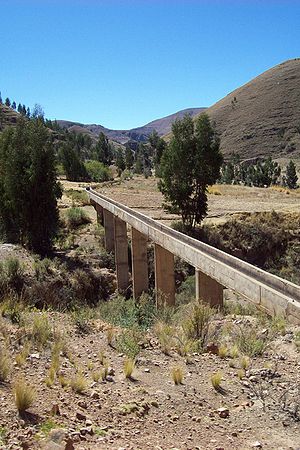
Erosion
Erosion is when materials are removed from the surface and changed into something else. It only works by hydraulic actions and transport of solids in the natural environment, and leads to the deposition of these materials elsewhere...
and pollution due to agricultural runoff. Nearly 41% of Bolivia's national territory has lost its production capacity due to soil erosion. For example, in western regions of Oruro
Oruro Department
Oruro is a department in Bolivia, with an area of 53,588 km². Its capital is the city of Oruro. At the time of census 2001 it had a population of 391,870.- Provinces of Oruro :...
, Potosi
Potosí Department
Potosí Department is a department in southwestern Bolivia. It comprises 118,218 km² with 709,013 inhabitants . The capital is the city of Potosí....
and Tarija
Tarija Department
Tarija is a department in Bolivia. It is located in south-eastern Bolivia bordering Argentina to the south and Paraguay to the east. According to the 2001 census, it has a population of 391,226 inhabitants. It has an area of 37.623 km²...
, close to 45,000 square kilometers have low soil productivity on account of erosion. The highland minifundios accelerate soil degradation processes. In the northern highlands, the production area of family agricultural production units is three to five hectares. Excess grazing
Overgrazing
Overgrazing occurs when plants are exposed to intensive grazing for extended periods of time, or without sufficient recovery periods. It can be caused by either livestock in poorly managed agricultural applications, or by overpopulations of native or non-native wild animals.Overgrazing reduces the...
and other agricultural activities have contributed to salinization and soil compression.
Agricultural runoff is one of the main contributors to water pollution
Water pollution
Water pollution is the contamination of water bodies . Water pollution occurs when pollutants are discharged directly or indirectly into water bodies without adequate treatment to remove harmful compounds....
in Bolivia, together with domestic municipal wastewater
Wastewater
Wastewater is any water that has been adversely affected in quality by anthropogenic influence. It comprises liquid waste discharged by domestic residences, commercial properties, industry, and/or agriculture and can encompass a wide range of potential contaminants and concentrations...
and dumping by industries and mines. The greatest percentage of the pollution load is due to diffuse dumping from agricultural and fishing activities and runoffs of urban areas. There are no regulations or controls over major dumping from non-specific sources, despite its volume and toxicity.

